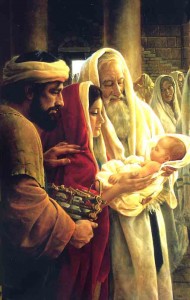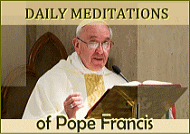Kuwait City, 2.02.2014.
Homily of the Apostolic Nuncio
His Grace Archbishop Petar Rajič 
Mal 3:1-4; Heb 2:14-18; Lk 2:22-40
Forty days after his birth, Mary and Joseph brought the child Jesus to the temple of Jerusalem as was the custom at the time, in order to present him to the Lord, since the law of Moses prescribed that all first born sons be offered to God. At the presentation, Mary and Joseph offer the Son of God who is God’s gift of himself to the world, back up to the Father. This act is also a prelude to what will happen one day on Calvary, where Jesus will freely give up his life in sacrifice for the sins of many.
During the presentation, we see how there was a giving and receiving going on, between God and his faithful ones. The elderly Simeon is described as a righteous and devout man, upon whom the Holy Spirit rested. He received a revelation, “that he should not see death before he had seen the Christ of the Lord”. This revelation itself was a great consolation for Simeon, that while still in this world he would be able to gaze upon the Messiah with his own eyes and hold him in his hands. Simeon’s experience speaks to us of the closeness of God and how he wishes to reveal himself to all who believe in him, who seek him with expectation and who are willing to accept him as he is.
The Lord is a personal God who can be encountered, and we too can receive the consolation of his closeness and recognize his saving work in our lives, if we have the patient and enduring faith of Simeon. Even though our lives can often be a mixture of moments of light and darkness, joy and sadness, hope and despair, grace and sin, the Lord nevertheless reveals himself as the light of the world. He comes today as well, to offer us his divine light that gives our lives purpose and enables us to become partakers in his light for others.
Upon having his wish fulfilled, Simeon praised God and could then accept his own death peacefully, for he saw with his own eyes the salvation of God in person, the light of the world and glory of his people Israel. God had fulfilled his promise by sending his Son as the Saviour of the world. Simeon had the privilege of holding the child Jesus in his arms. Through faith we too give praise to God for his many gifts for every grace is an assurance of God’s presence in our lives and his embracing love. Our love and gratitude to God for his generosity naturally compel us to share the faith, to give of ourselves, so that others may recognize him and his light in us.
Simeon later on, had some disturbing words for the Mother: “Behold, this child is destined for the fall and rise of many in Israel, and to be a sign that will be contradicted – and you yourself a sword will pierce – so that the thoughts of many hearts may be revealed”. This is the paradox of Jesus. He comes as Saviour bringing life for the whole world and yet there will be people who will reject his message of truth and life.
The second person who encounters the child Jesus at the Presentation is Anna, who is described as a prophetess, a widow advanced in years, who prayed and fasted constantly in the temple. Notice that both Simeon and Anna are described as very pious people, who lived in expectation of the coming of the Lord. There is an important lesson here for all of us and that is to be patient, constant, faithful, hopeful in seeking the Lord and awaiting for the consolation of his graces and his revelation to us. Many of us might be impatient with God who chooses to remain invisible and silent, who thirsts for our desire of him, yet for those who hunger and thirst for him, who seek him with all their heart, the Lord provides them with the knowledge of his presence within, which gives lasting peace and joy.
Salvation begins for us when we become like Anna or Simeon and accept the Lord Jesus into our arms as the most precious gift we could ever receive in life, for in accepting him, we are receiving the light and salvation of the world.

